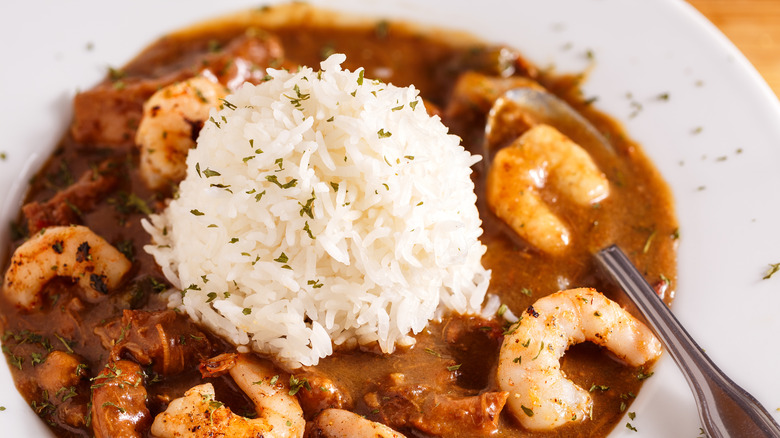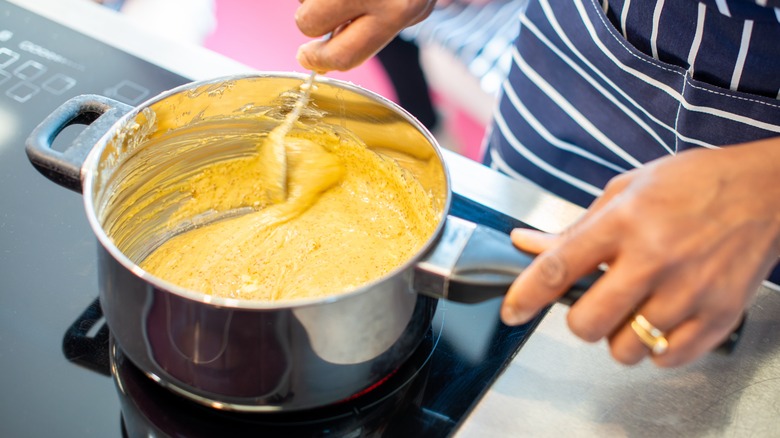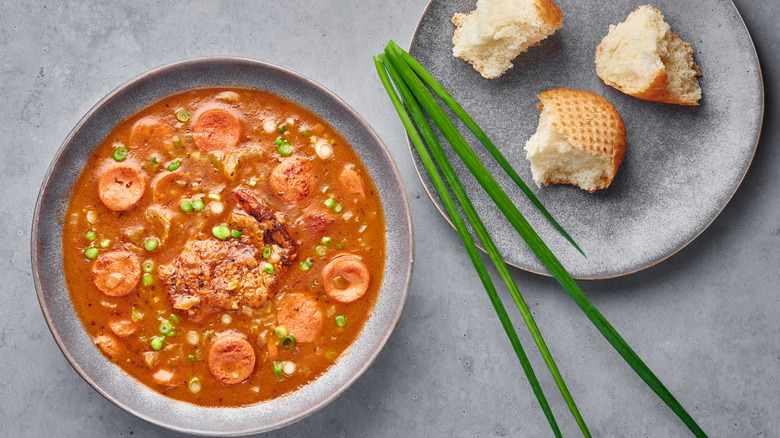Why It's Crucial To Add Plenty Of Roux To Gumbo
One of the best examples of America's melting pot of cultural influences is the cuisine of the Creole and Cajun peoples that have inhabited New Orleans. There's no dish that exemplifies this tradition more than gumbo.
Greater Iberia Chamber of Commerce claims that it's likely the earliest forms of gumbo were made in West Africa. According to the Southern Foodways Alliance though, the first documented appearances of gumbo pop up in New Orleans in the early 19th century. Cookbooks that would pop up decades later show the versatility of the dish as it is flavored with a variety of meats and fish. This includes our favorite renditions with duck and andouille sausage, or chicken and sausage.
While gumbo toppings might not be set in stone, one ingredient that can't be skipped is a good roux. Michelin Guide says that roux is a mixture of cooked flour and fat used to thicken sauces, but it takes on a unique role in gumbo that makes it irreplaceable.
What is a roux?
Most people are familiar with a roux for their ability to thicken sauces and gravies. According to Michelin Guide, by cooking flour with fat before adding it to drippings from roast turkey or pork, the flour granules are able to swell without clumping together. The starch molecules in the flour are coated by the fat while the two are heated and mixed. This lets them absorb the water in the drippings and swell which thickens the sauce.
Making a roux is considered a classic French culinary technique, but it's not the same as those found in gumbo. Cajun roux differs from the French version in a few ways. Atco Blue Flame Kitchen points out that a classic French roux uses butter for its fat, but the Cajun version usually features oil or lard instead. One reason for this is that the Cajun roux is also cooked to a dark brown hue as opposed to the light yellows and hazelnuts of the French roux. These fats have a higher smoke point that allows the flour to cook down more than it would in butter.
MasterClass adds that cooking the roux this way comes with a trade-off. While a darker roux will yield a more complex flavor, it also lessens its ability to add body to a sauce. But that doesn't mean it isn't any less essential to gumbo.
Why roux is so important to gumbo
Roux is usually used to help thicken gravies and sauces, but in gumbo, it's mostly used for flavor. According to Britannica, gumbo doesn't rely on a roux for thickness because it often contains okra. Okra is well known for its ability to add body to a sauce or soup just as well as a roux. Harvest to Table says that okra becomes slippery and gelatinous when it's cooked. If okra isn't present in the dish, then filé is traditionally added instead. This is a form of dried, pounded sassafras leaves that were used by Choctaw Native Americans as a thickening agent, per Harvest to Table.
MasterClass is correct that a darker roux in gumbo will not work to thicken the stew. Gumbo has other ingredients that give it its body. Instead, the dark roux is there to add the nutty, caramelized flavor that can only come from long cooking times and using oil or lard in the base.


